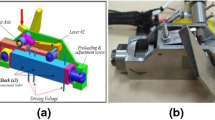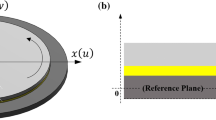Abstract
Multi-layer piezoelectric actuators (MPA) are widely used precision actuators. For design and optimization of MPA-based applications with a complex structure, finite element method, which can achieve a high computation accuracy, is widely applied in finite element analysis software for computation and analysis. However, MPA are commonly made of hundreds of thin piezo layers and the piezoelectric material involves electro-mechanical coupled fields, which makes it cumbersome to directly implement them in finite element analysis software and hard to solve. In this paper, it is shown that the multi-layer and electro-mechanical coupled-field MPA can be simply considered as a homogeneous mechanical solid with a pair of equivalent forces acting on the two ends. This equivalent model can greatly facilitate the implementation of MPA in finite element analysis software and cut down computational cost for design and optimization of MPA-based applications. The rationale behind the equivalent model is unveiled and the equivalent force input is derived with respect to voltage input in terms of the standard 3D piezoelectric coefficients. The effectiveness of the equivalent model is further verified by conventional model of MPA via FE simulations in ANSYS.


















Similar content being viewed by others
References
Adriaens H, De Koning W, Banning R (2000) Modeling piezoelectric actuators. IEEE/ASME Trans Mechatron 5:331–341
Ahmad I, Abdurraqeeb AM (2017) Tracking control of a piezoelectric actuator with hysteresis compensation using RST digital controller. Microsyst Technol 23:2307–2317
Avdiaj S, Setina J, Syla N (2009) Modeling of the piezoelectric effect using the finite-element method (FEM). Mater Tehnol 43:283–291
Bazghaleh M, Grainger S, Mohammadzaheri M, Cazzolato B, Lu TF (2013) A digital charge amplifier for hysteresis elimination in piezoelectric actuators. Smart Mater Struct 22:075016
Bloomfield PE (2002) Multilayer transducer transfer matrix formalism. IEEE T Ultrason Ferr 49:1300–1311
Chen XB, Zhang QS, Kang D, Zhang WJ (2008) On the dynamics of piezoactuated positioning system. Rev Sci Instrum 79:116101
Cheng T, He M, Li H, Lu X, Zhao H, Gao H (2017) A novel trapezoid-type stick-slip piezoelectric linear actuator using right circular flexure hinge mechanism. IEEE Trans Ind Electron 64:5545–5552
Goldfarb M, Celanovic N (1997) Modeling piezoelectric stack actuators for control of micromanipulation. IEEE Control Syst 17:69–79
Krimholtz R, Leedom DA, Matthaei GL (1970) New equivalent circuits for elementary piezoelectric transducers. Electron Lett 6:398–399
Leang KK, Devasia S (2007) Feedback-linearized inverse feedforward for creep, hysteresis, and vibration compensation in AFM piezoactuators. IEEE Trans Control Syst Technol 15:927–935
Lee J, Kwon WS, Kim KS, Kim S (2011) A novel smooth impact drive mechanism actuation method with dual-slider for a compact zoom lens system. Rev Sci Instrum 82:085105
Li J, Huang H, Zhao H (2018) A piezoelectric-driven linear actuator by means of coupling motion. IEEE Trans Ind Electron 65:2458–2466
Liu X, Wang J, Li W (2018) Dynamic analytical solution of a piezoelectric stack utilized in an actuator and a generator. Appl Sci 8:1779
Mason WP (1948) Electromechanical transducers and wave filters, 2nd edn. D. Van Nostrand Company, Inc., Princeton, pp 200–399
Meitzler A, Tiersten H, Warner AW et al (1988) 176-1987-IEEE standard on piezoelectricity. IEEE Ultrasonics, Ferroelectrics, and Frequency Control Society INSPEC Accession Number: 3237638. https://doi.org/10.1109/ieeestd.1988.79638
Miri N, Mohammadzaheri M, Chen L (2015) An enhanced physics-based model to estimate the displacement of piezoelectric actuators. J Intell Mater Syst Struct 26:1442–1451
Morita T, Niino T, Asama H, Tashiro H (2001) Fundamental study of a stacked lithium niobate transducer. Jpn J Appl Phys 40:3801
Morris SA, Hutchens CG (1986) Implementation of Mason’s model on circuit analysis programs. IEEE T Ultrason Ferr 33:295–298
Nikishkov GP (2004) Introduction to the finite element method. University of Aizu, Aizu, pp 15–31
Peng Y, Ito S, Sakurai Y, Shimizu Y, Gao W (2013) Construction and verification of a linear-rotary microstage with a millimeter-scale range. Int J Precis Eng Manuf 14:1623–1628
Polit S, Dong J (2011) Development of a high-bandwidth XY nanopositioning stage for high-rate micro-/nanomanufacturing. IEEE/ASME Trans Mechatron 16:724–733
Redwood M (1961) Transient performance of a piezoelectric transducer. J Acoust Soc Am 33:527–536
Shimizu Y, Peng Y, Kaneko J, Azuma T, Ito S, Gao W, Lu T-F (2013) Design and construction of the motion mechanism of an XY micro-stage for precision positioning. Sens Actuat A Phys 201:395–406
Sun L, Wang J, Rong W, Li X, Bao H (2008) A silicon integrated micro nano-positioning XY-stage for nano-manipulation. J Micromech Microeng 18:125004
Tanikawa T, Arai T (1999) Development of a micro-manipulation system having a two-fingered micro-hand. IEEE T Robot Autom 15:152–162
Tian Y, Zhang D, Shirinzadeh B (2011) Dynamic modelling of a flexure-based mechanism for ultra-precision grinding operation. Precis Eng 35:554–565
Wang J, Shi Z, Han Z (2013) Analytical solution of piezoelectric composite stack transducers. J Intell Mater Syst Struct 24:1626–1636
Wang S, Rong W, Wang L, Pei Z, Sun L (2017) Design, analysis and experimental performance of a novel stick-slip type piezoelectric rotary actuator based on variable force couple driving. Smart Mater Struct 26:055005
Xu Q, Li Y, Xi N (2009) Design, fabrication, and visual servo control of an XY parallel micromanipulator with piezo-actuation. IEEE Trans Autom Sci Eng 6:710
Yong YK, Mohemani SR (2013) Design of an inertially counterbalanced Z-nanopositioner for high-speed atomic force microscopy. IEEE T Nanotechnol 12:137–145
Zhang Y, Lu TF, Peng Y (2015) Three-port equivalent circuit of multi-layer piezoelectric stack. Sens Actuators A Phys 236:92–97
Zhang Y, Lu TF, Al-Sarawi S (2016) Formulation of a simple distributed-parameter model of multilayer piezoelectric actuators. J Intell Mater Syst Struct 27:1485–1491
Zhang Y, Tu Z, Lu TF, Al-Sarawi S (2017a) A simplified transfer matrix of multi-layer piezoelectric stack. J Intell Mater Syst Struct 28:595–603
Zhang Y, Lu TF, Gao W (2017b) Equivalent homogeneous model of D31-mode longitudinal piezoelectric transducers. J Intell Mater Syst Struct 28:2651–2658
Zhang Y, Peng Y, Sun Z, Yu H (2018) A novel stick–slip piezoelectric actuator based on a triangular compliant driving mechanism. IEEE Trans Ind Electron 1:1. https://doi.org/10.1109/tie.2018.2868274
Zubir MNM, Shirinzadeh B, Tian Y (2009) Development of a novel flexure-based microgripper for high precision micro-object manipulation. Sens Actuators A Phys 150:257–266
Acknowledgements
This research is funded by the China Postdoctoral Science Foundation (Grant no. 2017M622624) and National Natural Science Foundation of China (Grant nos. 61473093 and U1701266). Besides, the authors would like to thank the School of Mechanical Engineering, University of Adelaide, Australia for providing the equipment, facilities and assistances for this research.
Author information
Authors and Affiliations
Corresponding author
Additional information
Publisher's Note
Springer Nature remains neutral with regard to jurisdictional claims in published maps and institutional affiliations.
Rights and permissions
About this article
Cite this article
Zhang, Y., Lu, TF. On an equivalent model of multi-layer piezoelectric actuators for facilitating finite element simulations. Microsyst Technol 25, 4455–4464 (2019). https://doi.org/10.1007/s00542-019-04464-6
Received:
Accepted:
Published:
Issue Date:
DOI: https://doi.org/10.1007/s00542-019-04464-6




